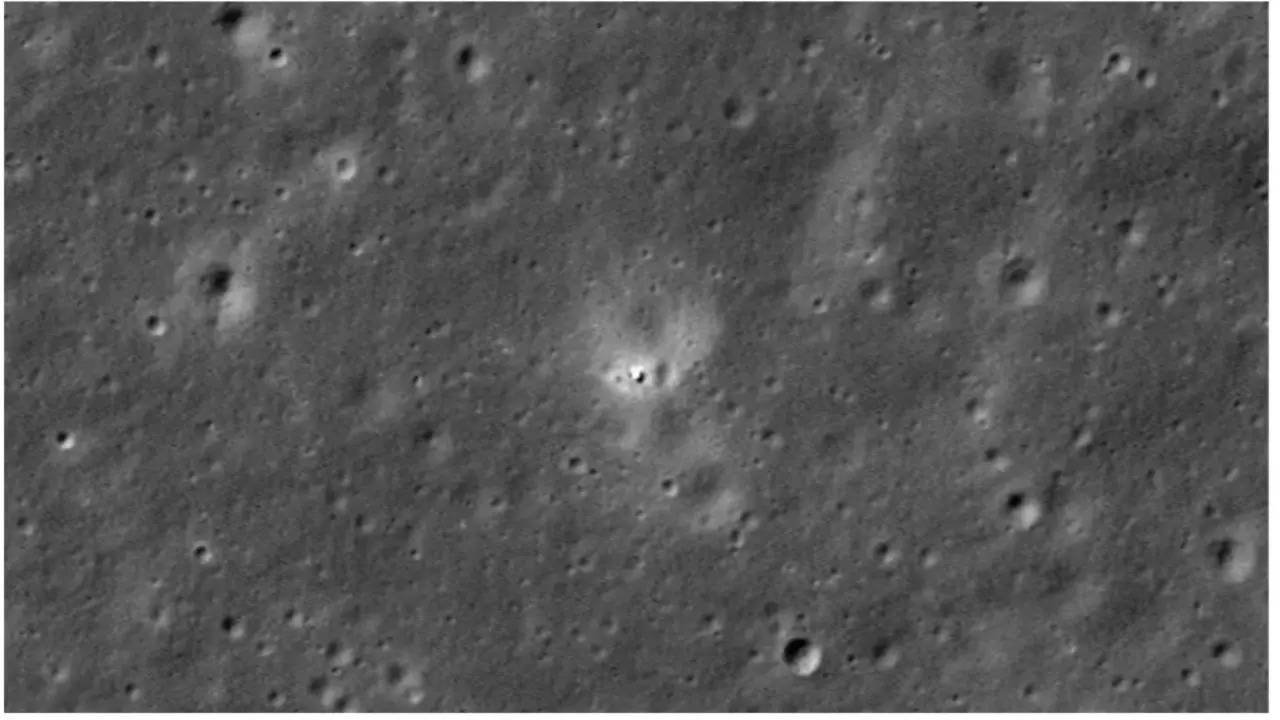Nasa‘s Lunar Reconnaissance Orbiter (LRO) captured its first glimpse of the Chinese Chang’e 6 spacecraft, which is currently situated on the far side of the moon, the spacecraft appears as a small group of bright pixels in the center of the image taken by the LRO on June 7, 2024.
The Lunar Reconnaissance Orbiter (LRO) captured images of China’s Chang’e 6 sample-return spacecraft on the lunar far side, five days after its successful landing, as per Nasa reports.
The landing site of Chang’e 6 is located on a mare unit, which is a “sea” of cooled volcanic rock, situated at the southern edge of the Apollo basin.
The Lunar Reconnaissance Orbiter Camera (LROC) team determined the precise landing site coordinates to be minus 41.6385 degrees north latitude and 206.0148 degrees east longitude, at an elevation of minus 17,244 feet (minus 5,256 m) relative to the average lunar surface. The estimated horizontal accuracy of the landing site is within plus or minus 100 feet (30 m).
“The increased brightness of the terrain surrounding the lander is due to disturbance from the lander engine and is similar to the blast zone seen around other lunar landers,” the LROC team wrote.
And also shared an image of the same area captured on March 3, 2022, prior to Chang’e 6’s landing, to highlight the presence of the spacecraft on the lunar surface and provide a comparison.
According to Mark Robinson, the lead scientist of the high-resolution camera system aboard LRO, the Chang’e 6 lander is positioned between two craters that are comparable in size to the spacecraft itself, and is located on the periphery of a less prominent crater, measuring approximately 165 feet (50 meters) in diameter.
According to Robinson and his colleagues at Arizona State University, basaltic lava erupted south of Chaffee S crater around 3.1 billion years ago and flowed downhill towards the east until it encountered a local topographic high, likely associated with a fault.
According to Nasa, the LROC image description states, “Several wrinkle ridges in this region have deformed and raised the mare surface. The landing site sits approximately halfway between two of these ridges. The lava flow also overlaps a slightly older flow (~3.3 Ga), visible further east, but the younger flow is distinctive because it has higher iron oxide (FeO) and titanium oxide (TiO2) abundances.” In this context, “Ga” is an abbreviation used by scientists to represent “billion years ago.”
Following the successful acquisition of lunar samples, the ascender segment of the probe lifted off from the moon’s surface on June 3, carrying its invaluable payload.
The ascender segment then rendezvoused with the Chang’e 6 mission orbiter, where the lunar samples were transferred. With its task complete, the returner segment remains in lunar orbit, patiently waiting for the opportune moment to embark on its journey back to Earth.
If all goes according to plan, the mission’s return capsule, along with its precious lunar collectibles, is anticipated to touch down on Earth around June 25. The capsule will make its landing using parachutes at a predetermined site in Siziwang Banner, located in the Inner Mongolia Autonomous Region of northern China, marking the successful conclusion of the 53-day space mission.
Chang’e 6, a lunar exploration mission, embarked on its journey from Hainan Province in southern China on May 3. The primary objective of this mission is to achieve a historic milestone by bringing back lunar samples from the moon’s far side, a feat never accomplished before.
The Lunar Reconnaissance Orbiter (LRO) captured images of China’s Chang’e 6 sample-return spacecraft on the lunar far side, five days after its successful landing, as per Nasa reports.
The landing site of Chang’e 6 is located on a mare unit, which is a “sea” of cooled volcanic rock, situated at the southern edge of the Apollo basin.
The Lunar Reconnaissance Orbiter Camera (LROC) team determined the precise landing site coordinates to be minus 41.6385 degrees north latitude and 206.0148 degrees east longitude, at an elevation of minus 17,244 feet (minus 5,256 m) relative to the average lunar surface. The estimated horizontal accuracy of the landing site is within plus or minus 100 feet (30 m).
“The increased brightness of the terrain surrounding the lander is due to disturbance from the lander engine and is similar to the blast zone seen around other lunar landers,” the LROC team wrote.
And also shared an image of the same area captured on March 3, 2022, prior to Chang’e 6’s landing, to highlight the presence of the spacecraft on the lunar surface and provide a comparison.
According to Mark Robinson, the lead scientist of the high-resolution camera system aboard LRO, the Chang’e 6 lander is positioned between two craters that are comparable in size to the spacecraft itself, and is located on the periphery of a less prominent crater, measuring approximately 165 feet (50 meters) in diameter.
According to Robinson and his colleagues at Arizona State University, basaltic lava erupted south of Chaffee S crater around 3.1 billion years ago and flowed downhill towards the east until it encountered a local topographic high, likely associated with a fault.
According to Nasa, the LROC image description states, “Several wrinkle ridges in this region have deformed and raised the mare surface. The landing site sits approximately halfway between two of these ridges. The lava flow also overlaps a slightly older flow (~3.3 Ga), visible further east, but the younger flow is distinctive because it has higher iron oxide (FeO) and titanium oxide (TiO2) abundances.” In this context, “Ga” is an abbreviation used by scientists to represent “billion years ago.”
Following the successful acquisition of lunar samples, the ascender segment of the probe lifted off from the moon’s surface on June 3, carrying its invaluable payload.
The ascender segment then rendezvoused with the Chang’e 6 mission orbiter, where the lunar samples were transferred. With its task complete, the returner segment remains in lunar orbit, patiently waiting for the opportune moment to embark on its journey back to Earth.
If all goes according to plan, the mission’s return capsule, along with its precious lunar collectibles, is anticipated to touch down on Earth around June 25. The capsule will make its landing using parachutes at a predetermined site in Siziwang Banner, located in the Inner Mongolia Autonomous Region of northern China, marking the successful conclusion of the 53-day space mission.
Chang’e 6, a lunar exploration mission, embarked on its journey from Hainan Province in southern China on May 3. The primary objective of this mission is to achieve a historic milestone by bringing back lunar samples from the moon’s far side, a feat never accomplished before.

